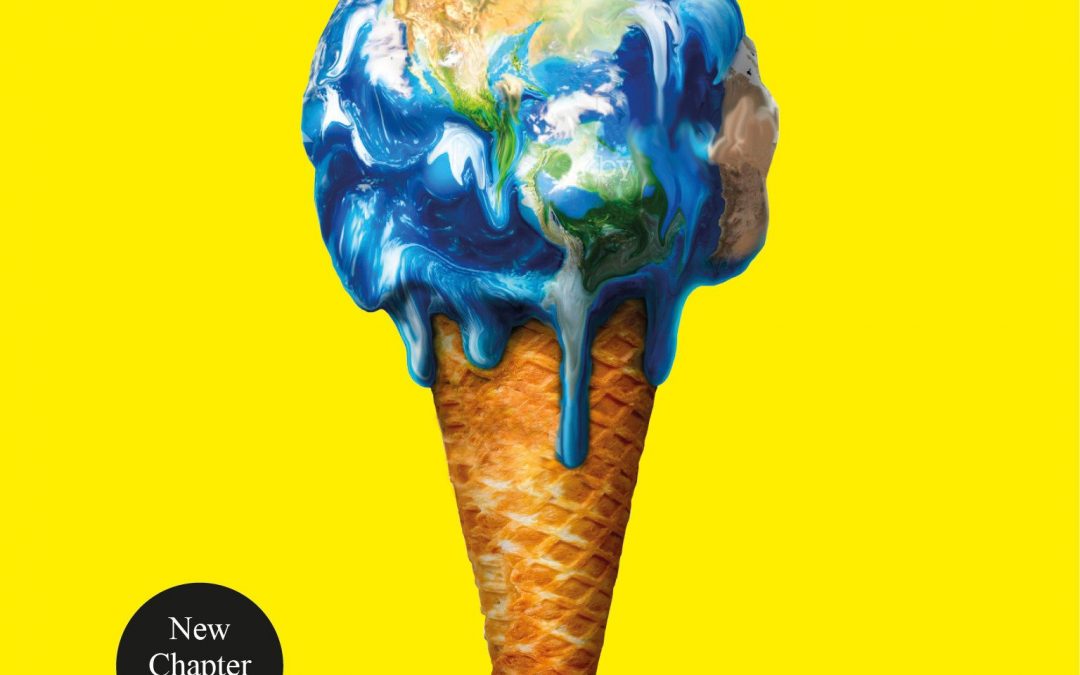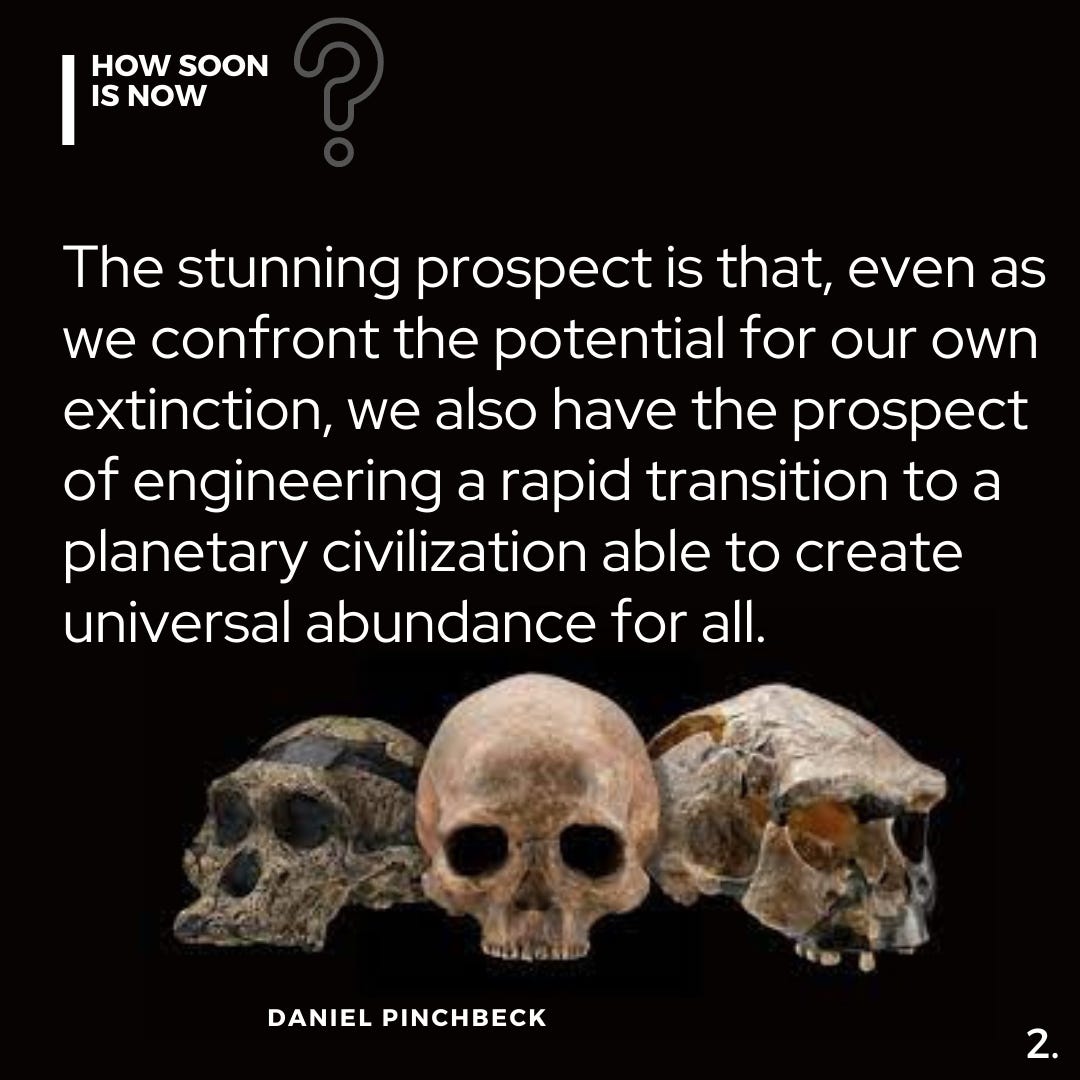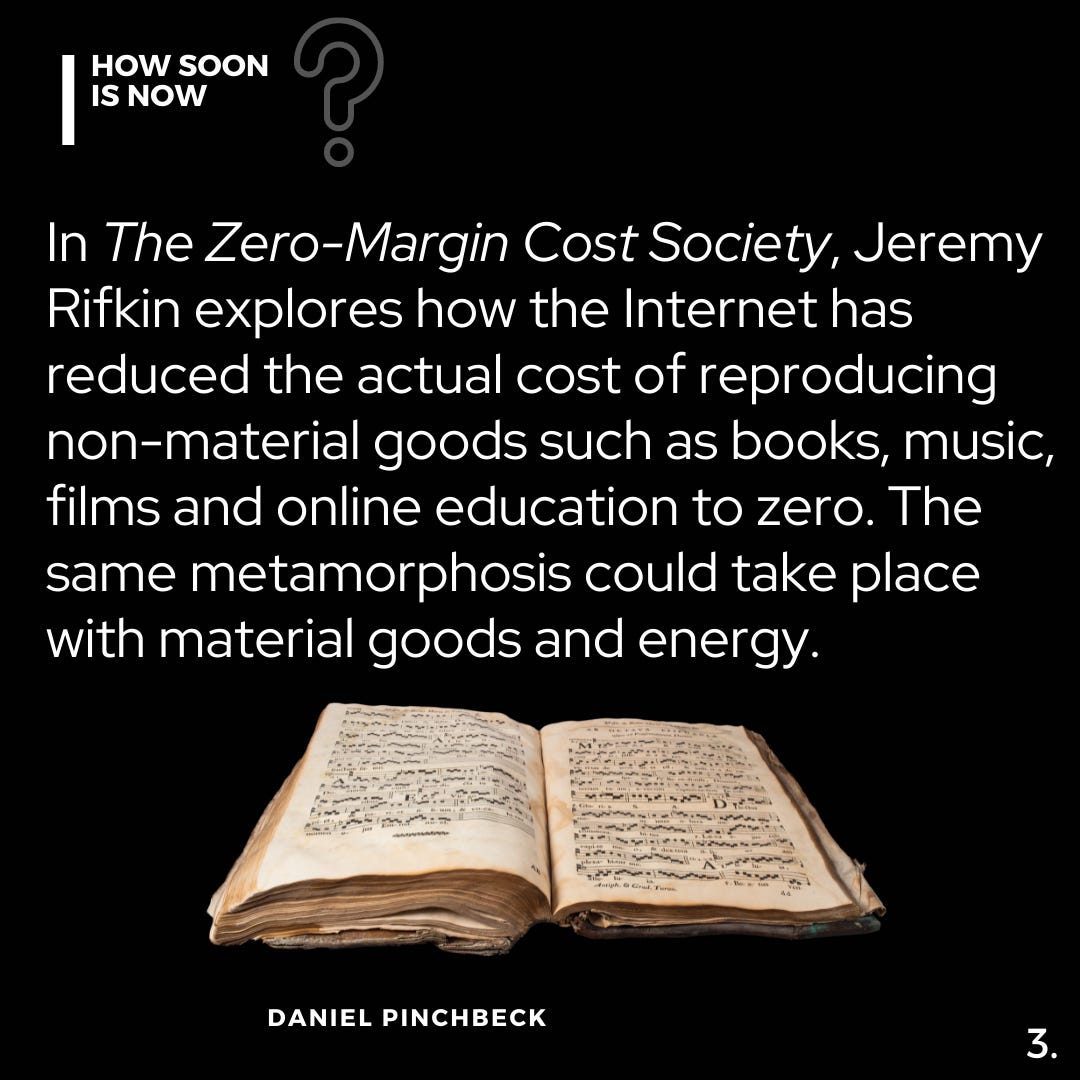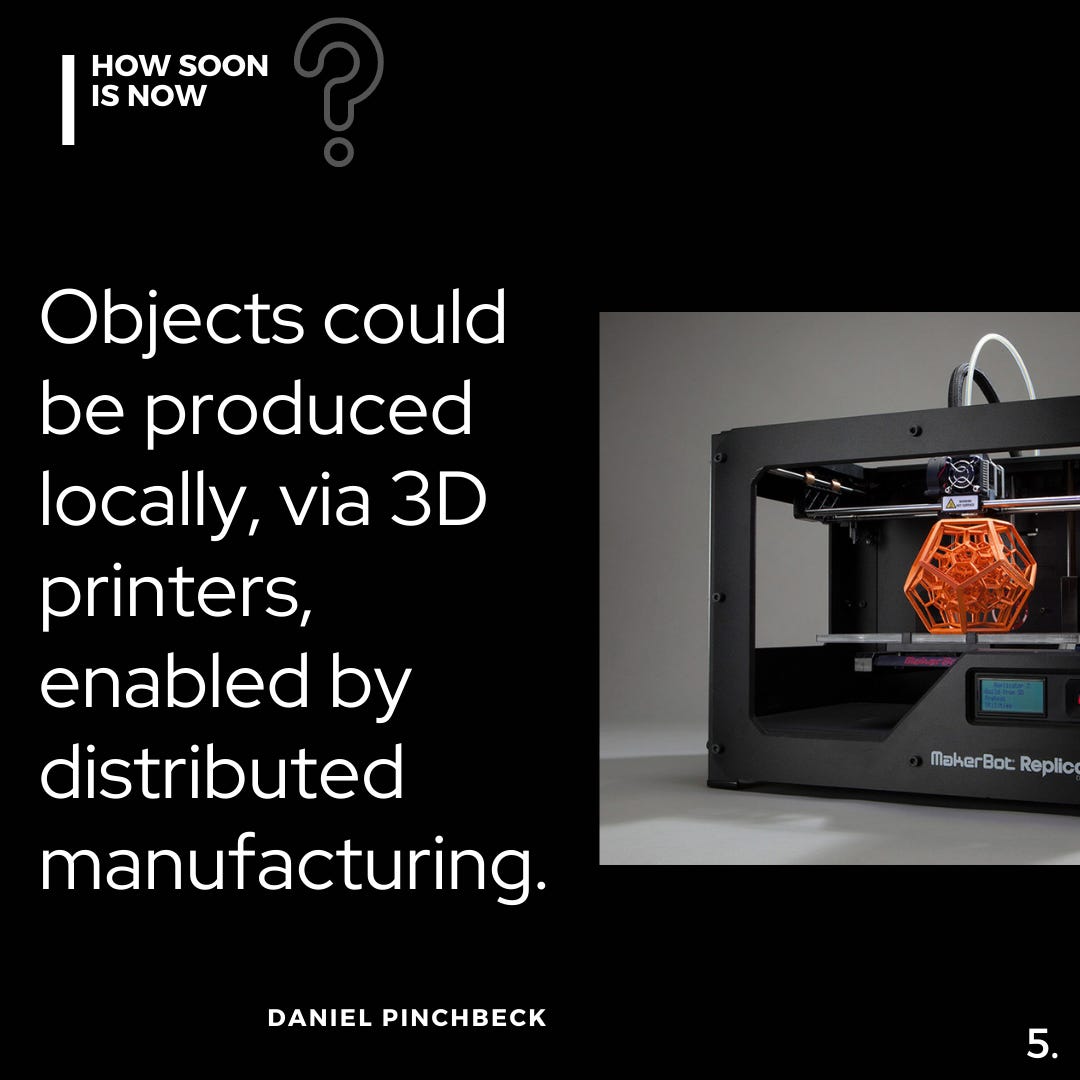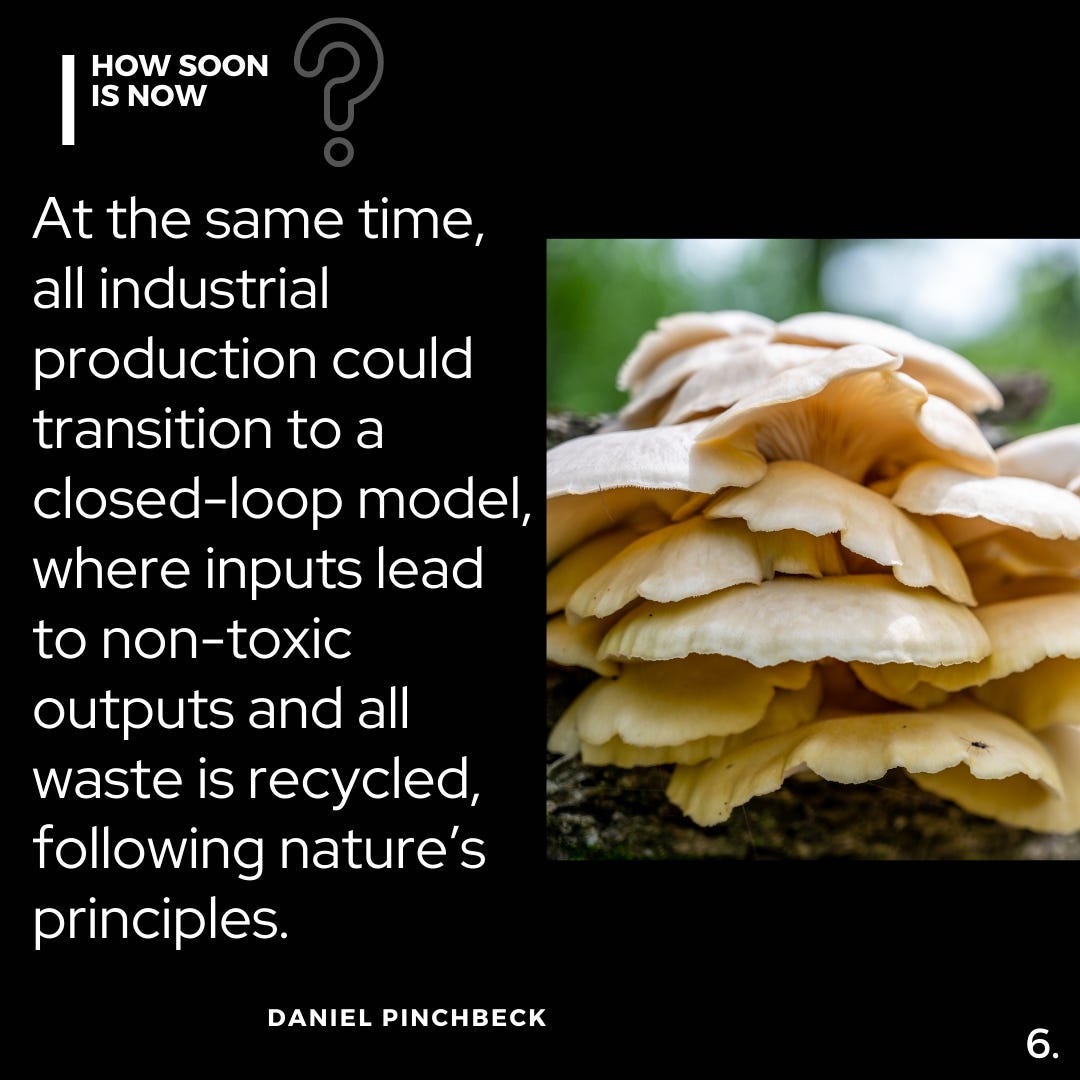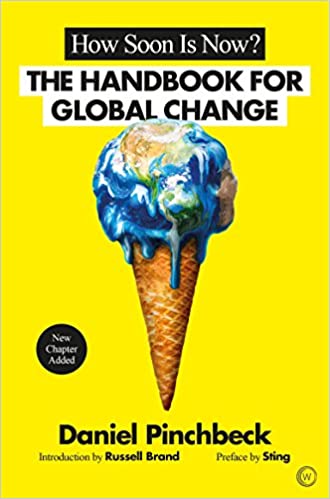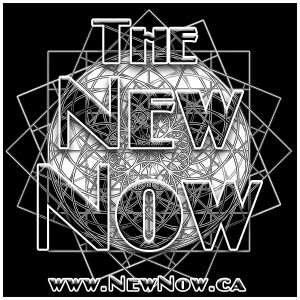in an ongoing, symbiotic relationship with the ecology of the Earth as a whole system
In How Soon Is Now (2016), I attempted to zoom as far out as possible to devise a vision and an action plan for humanity’s future. Writing it, I sometimes imagined myself as a long-living extraterrestrial, observing the Earth for millennia from some nearby planet. From where we are, immersed in rapid-fire events, our world seems chaotic, cacophonous. We lurch from crisis to crisis with no end in sight. Many people feel we are inexorably heading toward civilizational collapse or even extinction. Certainly, anything is possible.
However, when we pull back, we notice that humanity, collectively, as a species-being, seems to be acting in the manner that imitates processes we often find in biological evolution — in fetal development, for example. Over the last centuries, we first linked the world together via trade routes, highways, and so on. Then we built a communications infrastructure that meshes the world together continuously, as if we are developing a global brain. The power of technology has temporarily hypnotized many of us, leading to a popular belief that technological development, in itself, constitutes humanity’s purpose, even if super-intelligent machines eventually replace us.
What I propose in How Soon Is Now is that we take a different direction. I believe we still haven’t scratched even the surface of our potential as a species. To do so, our focus must turn from external development to inner development. Technology is not meant to control us or be our master. Our machines should serve us. They should help us to harmonize and pacify the planetary environment so we can liberate ourselves. When we break free of obsolete forms of the struggle for survival, we can develop our full creative and psychic capacities.
This will also require a comprehensive redesign of our social — political and economic — systems, as I explore in the book. At the moment, humanity is still trapped within antiquated ideologies and hierarchical power structures that block our evolutionary potential. It is quite obvious that these legacy systems are broken.
To take two examples from current events: Publicly traded corporations are unable to coordinate to address the ecological emergency, which becomes increasingly dire. The historical perpetuation of dictatorships in countries like Russia and China concentrates world-destroying power in the hands of men — sociopathic personalities — who used ruthless methods to climb to the top. These are very unsustainable scenarios.
I don’t think How Soon Is Now is a perfect book. Perhaps I simplified too much. I wrote it as plainly as I could, hoping to inspire people to build the unified social movement that I believe we need.
What the book proposes is tantamount to social engineering — something that makes many people uneasy or that they quickly reject. Yet, as I note in the excerpt below, we have already been “socially engineered” — by consumer Capitalism, by a culture that normalizes violence and allows for vast disparities in wealth and hordes of homeless (something inconceivable for many indigenous cultures that were based on reciprocity). Still, I think anyone would benefit from considering my ideas even if they stir up counter-arguments.
We definitely need a vision of where we go from here — and beyond a vision, a strategic action plan.
From the 1960s until today, many people have taken personal journeys of initiation, rediscovering mysticism and shamanism, and embracing an expanded awareness of psyche and cosmos. This collective voyage of initiation can’t be completed, however, until those who have taken their personal vision quests are able to bring their new knowledge back into our society – to have it fully absorbed, welcomed and integrated. The best option is that we undertake a peaceful, deliberately designed and non-destructive system change.
We can think of our current civilization – its technical and socio-political infrastructure, its ideology and beliefs – as an operating system, much like the software that runs our computers. Now we need to reboot and install a new system software. A new social design could, eventually, give every human being the opportunity to flourish and thrive, to live creatively, without fear for their future. Accomplishing this is a great mission that will require a truly rational, empathic application of our technical and creative powers.
We must build this new program – engineer this global reboot – within the next decades. If we can accomplish this, we will have passed the test that the universe has set for us. I realize that some people will worry I am proposing a nefarious form of ‘social engineering’. The truth is that we have already been socially engineered. As Terence McKenna noted, culture is our operating system. We have been conditioned since birth to accept a system of global control, elite privilege and military domination. Identity is, to a great extent, a social construction.
‘The only thing that one really knows about human nature is that it changes’, Oscar Wilde wrote. ‘Change is the one quality we can predicate of it. The systems that fail are those that rely on the permanency of human nature, and not on its growth and development.’ I think this is true. It points towards the enormous task as well as the great opportunity confronting us now. The Earth will not be able to support a global civilization based on hyper-consumerism and hyper- individualism for much longer. Therefore, we must change human nature as it is currently known. We must do this – not only to survive, but also to reach our full potential as a species.
Our technocratic society uses the mass media as an instrument of mind control and threatens those who dissent or resist with violent reprisals (for example, nonviolent drug offenders seeking to explore their own consciousness face draconian prison sentences). Through incessant media bombardment and government fear-mongering, people are conditioned to believe that oppression, injustice, violence and inequality are normal and inevitable. What we require is a new social design to liberate humanity from its prison. This redesign must also reckon with our darker and more destructive impulses and find ways to channel them.
My mission with this book is unabashedly utopian. To quote Wilde again (although remembered mainly as a playwright and dandy, he was also a brilliant social critic): ‘A map of the world that does not include Utopia is not worth even glancing at, for it leaves out the one country at which Humanity is always landing. And when Humanity lands there, it looks out, and, seeing a better country, sets sail. Progress is the realization of Utopias.’
Postmodern civilization is already a pseudo-utopia. Over the last few centuries, we have constructed an artificial paradise of consumer goods – the society of the spectacle – for those with the resources to enjoy it. Unfortunately, this artificial paradise is built on excessive waste and ecological destruction. It has created misery for those on the margins, the victims of famines, wars and genocides. By addressing its flaws, we can realize the next manifestation of our genius as a species – and achieve, in comparison, a true utopia.
I know it seems strange to discuss the imminent prospect of ecological meltdown on the one hand and the attainment of a practical utopia on the other. But such is the schizophrenic nature of our time. As we shall see, both outcomes seem plausible. In the near term, we may get a bizarre mix of the two.
I don’t think a massive dieback of the human population is inevitable – perhaps I refuse to believe it. But the longer we wait to relaunch our social operating system, the more difficult it will be to avert planetary catastrophe. We have already waited too long.
I seek to bring together the archaic and the postmodern, the visionary and the rational, the corporate and the anarchistic, in a viable synthesis. I don’t expect us to revert to old-fashioned eighteenth- century agrarianism, although I do think communities will need to grow more of their own food and become as self-sufficient as possible. I also don’t think we can regress all the way back to small-scale bands of hunter-gatherers, although there is a great amount we need to learn from indigenous and aboriginal cultures that supported their local ecology for thousands of years. Out of compassion, we must seek to maintain the current human population even as we radically reduce our burden on the Earth.
I don’t reject the potential of futuristic technologies – artificial intelligence, nanotechnology, biotechnology and so on – out of hand. But I think we must explore them with great caution, and with constant oversight from civil society. Right now, crucial decisions that impact on the biosphere in its entirety are left to engineers, corporations and financiers. Our current form of government was established in the late eighteenth century, when news as well as progress moved at a much slower speed than today. To deal with our rapidly changing circumstances, we need more than a reform – we need, I think, a new political-economic operating system.
In many cases, the promise of advanced technologies has been far greater than what they delivered. Each new level of technology also brings with it unforeseen negative consequences, requiring more innovation to fix. As the dark ecologist Paul Kingsnorth has noted, this has created an increasingly alarming, even world-endangering ‘progress trap’. As our civilization becomes more technologically complex, it also becomes more fragile. The prospect of the Singularity, promulgated by Google engineer Ray Kurzweil and other techno-utopians, is one we must investigate carefully. It is something like a ticking time bomb we must defuse.
The study of biological evolution – the history of life on Earth – reveals an inveterate tendency towards greater levels of cooperation, coordination and symbiosis. This idea may seem surprising at first. As part of the paradigm we inherited – the one we are now leaving behind – many thinkers and scientists placed their focus, instead, on the competitive, aggressive and destructive aspects of nature. This view of biology as a constant struggle for life meshed perfectly with the predatory economic mode of capitalism. This idea has now been superseded by a new view of life as an intricately networked phenomenon, where organisms support each other far more than they compete.
According to biologist Lynn Margulis, the author of Microcosmos, who developed the Gaia hypothesis with scientist James Lovelock, ‘The trip from greedy gluttony, from instant satisfaction to long-term mutualism, has been made many times in the microcosm. While destructive species may come and go, cooperation itself increases through time.’
We can find the most accessible example of cooperation and symbiosis as the pattern of evolution in our own bodies. Our bodies are made out of a hundred trillion cells and vast colonies of microorganisms that work together seamlessly. In a previous stage of the Earth’s evolution, these organisms were fighting against each other for scarce resources. During a period of crisis, they figured out ways to collaborate to construct more complex structures – organs, like skin, eyes and lungs. In a way, all human technologies are just recapitulations of technological feats we already find in the microcosm. Long before the Internet, viruses exchanged information – genetic code – around the world at high speed. When humans cooperate to build a satellite dish, it is not that dissimilar to the communities of specialized cells and microorganisms that assemble an eye or an ear. ‘As tiny parts of a huge biosphere whose essence is basically bacterial, we – with other life forms – must add up to a sort of symbiotic brain which it is beyond our capacity to comprehend or truly represent,’ Margulis wrote.
Individual cells in our bodies do not hoard wealth – excess energy – but store it in deposits of fat that are freely available to the cellular community as a whole. Cells contribute their efforts to the collective body without seeking more for themselves, as energy flows seamlessly, going wherever it is needed. Without any competition, cells as well as organs work with maximum efficiency for the success of the whole.
We can understand the process we are undergoing as purposeful, teleological and even implicitly designed – in the same way that nature designs conception, fetal development and birth on the level of an individual organism. Humanity, as a whole, constitutes a planetary super-organism, one unified being, in an ongoing, symbiotic relationship with the ecology of the Earth as a whole system.
Paid subscriptions allow me to continue my work. Subscribers get special offers, reduced prices, and unique content (more to come).
– Come Like Us on Facebook – Check us out on Instagram –
– Sign Up for our Newsletter –


